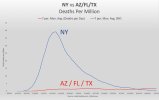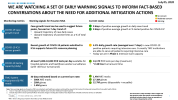Intriguing. I hadn't considered that an immunologist might have such a starkly different view from an epidemiologist, but I don't really know much about medicine. It was written about a month ago before the spikes started. I genuinely want the author to be right, but I wonder how he squares the statement that the pandemic is dying off as summer starts with the increased spread in the last couple of weeks?
Europe hasn’t been seeing the same spikes that we have in the US. I also don’t think the author is too worried about case count increase; the death rate here, and worldwide, continues to decline. In fact, deaths have declined 92% since our high on April 21st. But the media isn’t REPORTING that data.
Further, if you look at normalized data, this hasn’t been that large of a spike. There’s a post a while back about that, as though we’d been doing 600,000 tests a day here all along. I think the number of people testing positive for the virus would have been here all along, we just didn’t know about them. Any estimates of actual case that approximated what we know now were dismissed as being impossibly high.
If one thinks critically about some of the differences there are some things to consider for the continued spread. For example, the seasonal temperature rise across the southern and southwestern states. Some would attribute this to opening up and because they’re a large number of “Red” states, but then how does one reconcile California? Another example is the widespread protesting that occurred in the month of June. State and city specific sure, but wouldn’t it seem to defy science that those events didn’t perhaps cause massive spread?
Also, the media IS reporting about how terrible things are in some select (Republican) states. Here’s a comparison graph of the deaths per million people. Remember 19 weeks ago when it was “two weeks to flatten the curve”? By that marker Texas, Florida, and Arizona should be commended for spreading out the case load that well and not overwhelming hospitals.






